Michelle L. Hamilton's Blog, page 2
April 11, 2017
Spiritualism In The Lincoln White House | Michelle Hamilton | Edge Of Th...
Last week I had the pleasure of being a guest on Mike Ricksecker's and Vanessa Hogle's YouTube show The Edge of the Rabbit Hole where I discussed my book "I Would Still Be Drowned in Tears": Spiritualism in Abraham Lincoln's White House. It was a great hour and I enjoyed my time on the show.
"I Would Still Be Drowned in Tears": Spiritualism in Abraham Lincoln's White House is available on Amazon
"My Heart is in the Cause": The Civil War Diaries of Private James A. Meyers, 45th PA Volunteers is available on Amazon
Published on April 11, 2017 08:51
April 4, 2017
A Fredericksburg Ghost Story
Sometimes while researching I come across something completely unexpected. While preparing for a lecture about Civil War women diarist in Fredericksburg I came across this amazing story that I would like to share.
General John Minor was a solider in Revolutionary War and a general in the War of 1812. Minor entered politics and was an associate of James Monroe. A respected member of Fredericksburg, Minor had a large family and a large plantation called Hazel Hill. In June of 1816, Minor was in Richmond, Virginia attending the General Assembly when the following events occurred. This story was recorded by Minor's granddaughter Mary Isabella Blackford (1841-1928):
"My mother never did tell me this ghost story at all. I never heard it till after I was grown...My grandmother had kept it a dead secret forty years. The servants had strict orders not to mention it in Fredericksburg or anywhere. In those days servants had to mind. As far as I know, they never did tell it.
"General Minor was at that time a member of the General Assembly that was meeting in Richmond. My grandmother was not expecting him at all. She was sitting in her dining room at Hazel Hill about 6 o'clock that evening...with her sons, their tutor and my mother, when suddenly the door opened and the butler, an elderly colored man, came in and said, 'Mistress, did you know Master had come?' She rose from the table quite excited and said, 'No, Ben, I was not expecting General Minor. Where is he?'
"Then they all followed Ben out in the hall and saw [the General] at the lower end and just about to go upstairs. He turned a moment and looked at them and then went on up. He was in full evening dress. They could see his hand on the banister as he went up, and the ruffles at his wrist. Some went upstairs and searched every room but he was no where to be found. The family were all excited and distressed, not knowing what to think.
"At that very moment General Minor was at the Governor's Mansion attending a state dinner. Several hours later a man on horseback, his horse covered with foam, dashed into he yard with a letter to Grandma telling the sad news of the General's sudden death at the dinner party." (Source: Mine Eyes Have Seen The Glory: The Story of a Virginia Lady Mary Berkeley Minor Blackford 1802-1896 Who Taught Her Sons to Hate Slavery and to Love the Union by L. Minor Blackford (Cambridge, MA: Harvard University Press, 1954) pg. 8-9).
Sadly, Hazel Hill no longer stands, but there is a historical marker detailing the history of the property and Minor's accomplishments. For more information on Hazel Hill here.
General John Minor's remains were returned to Fredericksburg and buried in the Fredericksburg Masonic Cemetery. Visit his Find a Grave page here.
General John Minor was a solider in Revolutionary War and a general in the War of 1812. Minor entered politics and was an associate of James Monroe. A respected member of Fredericksburg, Minor had a large family and a large plantation called Hazel Hill. In June of 1816, Minor was in Richmond, Virginia attending the General Assembly when the following events occurred. This story was recorded by Minor's granddaughter Mary Isabella Blackford (1841-1928):
"My mother never did tell me this ghost story at all. I never heard it till after I was grown...My grandmother had kept it a dead secret forty years. The servants had strict orders not to mention it in Fredericksburg or anywhere. In those days servants had to mind. As far as I know, they never did tell it.
"General Minor was at that time a member of the General Assembly that was meeting in Richmond. My grandmother was not expecting him at all. She was sitting in her dining room at Hazel Hill about 6 o'clock that evening...with her sons, their tutor and my mother, when suddenly the door opened and the butler, an elderly colored man, came in and said, 'Mistress, did you know Master had come?' She rose from the table quite excited and said, 'No, Ben, I was not expecting General Minor. Where is he?'
"Then they all followed Ben out in the hall and saw [the General] at the lower end and just about to go upstairs. He turned a moment and looked at them and then went on up. He was in full evening dress. They could see his hand on the banister as he went up, and the ruffles at his wrist. Some went upstairs and searched every room but he was no where to be found. The family were all excited and distressed, not knowing what to think.
"At that very moment General Minor was at the Governor's Mansion attending a state dinner. Several hours later a man on horseback, his horse covered with foam, dashed into he yard with a letter to Grandma telling the sad news of the General's sudden death at the dinner party." (Source: Mine Eyes Have Seen The Glory: The Story of a Virginia Lady Mary Berkeley Minor Blackford 1802-1896 Who Taught Her Sons to Hate Slavery and to Love the Union by L. Minor Blackford (Cambridge, MA: Harvard University Press, 1954) pg. 8-9).
Sadly, Hazel Hill no longer stands, but there is a historical marker detailing the history of the property and Minor's accomplishments. For more information on Hazel Hill here.
General John Minor's remains were returned to Fredericksburg and buried in the Fredericksburg Masonic Cemetery. Visit his Find a Grave page here.
Published on April 04, 2017 10:15
April 1, 2017
Printed Fashions at Colonial Williamsburg
Last week a new exhibition at the Dewitt Wallace Decorative Arts Museum at Colonial Williamsburg opened for the public. "Printed Fashions: Textiles for Clothing and Home" examines the printed textiles that flooded the market from the late 17th century to early 19th century. Spurred on by new technologies and trade with India and Asia, British manufacturers found a wealth of inspiration for printed fabrics--and an eager public who quickly snapped up the fabric to decorate their homes and display their wealth through vibrant clothing.
The curators at Colonial Willamsburg gathered 75 examples of the best of 18th-19th century printed fabric. Many of the pieces have never been on display before. The selected pieces are simply breathtaking. The pieces dazzle the eye, and quickly banish any thoughts of Colonial era fashions and homes as dark, bland, or unfashionable. The colonists were just as fashion conscience as their English counterparts and quickly adapted the latest trends and fashions into their homes and wardrobes.
Below are just a few of the highlights on display:
 Caraco Jacket, with quilted petticoat c. 1775-1785. I love how the fichu is tucked into the front of the caraco. The fichu, wig, and jewelry are reproductions.
Caraco Jacket, with quilted petticoat c. 1775-1785. I love how the fichu is tucked into the front of the caraco. The fichu, wig, and jewelry are reproductions.
 Back view of the caraco jacket with the fichu draped over the shoulder.
Back view of the caraco jacket with the fichu draped over the shoulder.

Banyan c. 1770-1810. During this period, men were not afraid to wear bold colors and flowered fabrics. Banyan's were worn at home in private when a gentlemen took their waistcoats off for comfort. The cap kept the gentlemen's head warm when the wig was not being worn.
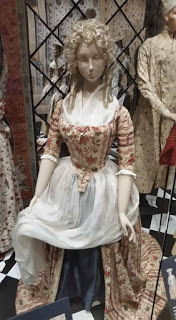
Gown and apron c. 1780-1790. This is a very fashionable gown and highlights the fashionable silhouette of the 1780s. My favorite part about this dress is that at the front of the bodice an extra strip of fabric was added across the top for modesty. I also liked how the apron is tucked under the V at the front of the waist.
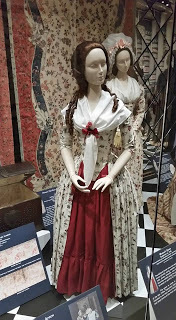
Gown c. 1785. This was my favorite gown in the exhibition. I love, love, love every part of this outfit. The wig, fichu, flowers, petticoat, and jewelry are reproduction.
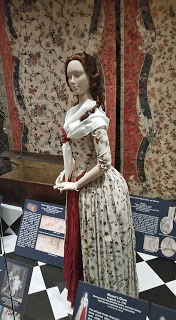
Side view of the gown.
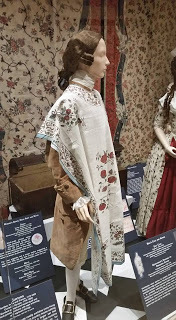
Gentleman's shaving or dressing apron c. 1750-1775. Worn while being dressed and shaved, the apron prevented the powder that dusted the wigs from getting on a gentleman's clothing.
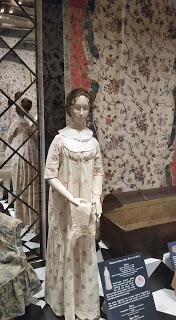
Gown c. 1800-1810. This is a beautiful example of the Empire style fashions. The fabric dates from c. 1790 suggesting that the dress was remodeled after the 1790s to reflect the changing fashions.

A close up view of the lovely sleeve trim.

Gown with removable sleeves c. 1805. This dress has removable sleeves which transformed a day dress into an elegant evening dress. I love the ruffles on the bodice for modesty.

Gown bodice and skirt panel c. 1790. Another example of a dress remade to reflect changes in fashion. The skirt panel had been connected to the bodice, but was removed at a later date.
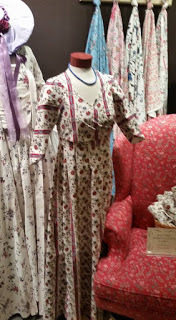
Reproduction gown in the Dewitt Wallace Decorative Arts Museum gift shop. This fabric was reproduced by Colonial Williamsburg, but has been retired. You think they would have waited till after the exhibit!
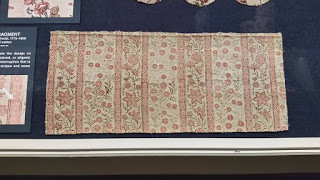
Fabric fragment c. 1775-1800. Colonial Williamsburg has reproduced this fabric and can be purchased here.
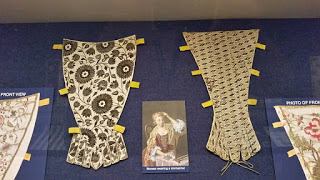
Two stomachers c.1720-1740. This is the back of the stomachers and would would not have been meant to be seen.
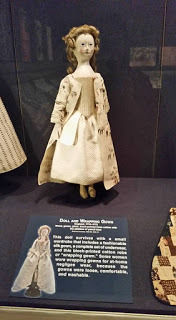
Doll in a wrapping gown c. 1770-1775. Dolls in the 18th century showcased the latest fashions and this doll came with a complete wardrobe of fashionable gowns and underpinnings.

Apron c. 1770-1775. A unique example of a bib apron from the 18th-century. I need to add on of these to my wardrobe!
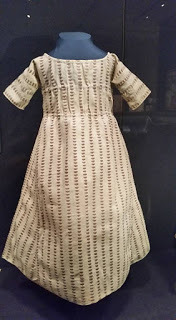
Child's gown or frock c. 1790. Guests to Colonial Williamsburg will recognize this gown and fabric as the inspiration for the outfit sold in the gift shops of CW.
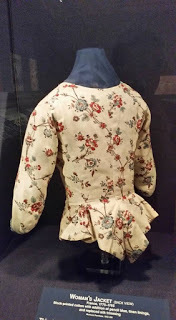
Back view of a jacket c. 1775-1785. The stomacher to this jacket has been lost.
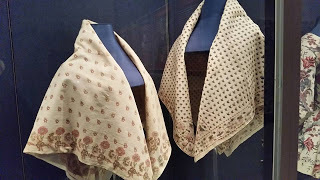
Kerchiefs c. 1795-1825. Printed kerchiefs added a dash of color to everyday wear.

Jacket c. 1780. Another example of fabric being reused to reflect changing fashions. The jacket dates to the late 1770s to early 1780s, but the fabric dates to an earlier period.
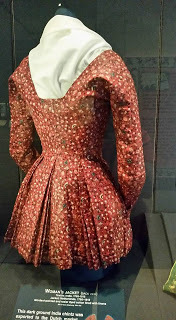
Jacket c. 1795-1815. Changing fashions are reflected in this jacket for everyday wear.
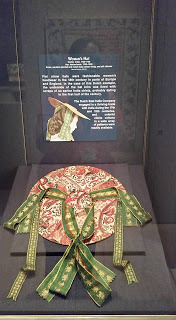
Hat c. 1780-1820. Cotton chintz used to line the inside of this fashionable straw hat.
I highly recommend a trip to Colonial Williamsburg to view "Printed Fashions." Pictures do not do justice to the beautiful fabric and fashions on display. The exhibit is scheduled to run for two years, so there is plenty of time.
For more information visit the official page here.
The curators at Colonial Willamsburg gathered 75 examples of the best of 18th-19th century printed fabric. Many of the pieces have never been on display before. The selected pieces are simply breathtaking. The pieces dazzle the eye, and quickly banish any thoughts of Colonial era fashions and homes as dark, bland, or unfashionable. The colonists were just as fashion conscience as their English counterparts and quickly adapted the latest trends and fashions into their homes and wardrobes.
Below are just a few of the highlights on display:
 Caraco Jacket, with quilted petticoat c. 1775-1785. I love how the fichu is tucked into the front of the caraco. The fichu, wig, and jewelry are reproductions.
Caraco Jacket, with quilted petticoat c. 1775-1785. I love how the fichu is tucked into the front of the caraco. The fichu, wig, and jewelry are reproductions. Back view of the caraco jacket with the fichu draped over the shoulder.
Back view of the caraco jacket with the fichu draped over the shoulder.
Banyan c. 1770-1810. During this period, men were not afraid to wear bold colors and flowered fabrics. Banyan's were worn at home in private when a gentlemen took their waistcoats off for comfort. The cap kept the gentlemen's head warm when the wig was not being worn.

Gown and apron c. 1780-1790. This is a very fashionable gown and highlights the fashionable silhouette of the 1780s. My favorite part about this dress is that at the front of the bodice an extra strip of fabric was added across the top for modesty. I also liked how the apron is tucked under the V at the front of the waist.

Gown c. 1785. This was my favorite gown in the exhibition. I love, love, love every part of this outfit. The wig, fichu, flowers, petticoat, and jewelry are reproduction.

Side view of the gown.

Gentleman's shaving or dressing apron c. 1750-1775. Worn while being dressed and shaved, the apron prevented the powder that dusted the wigs from getting on a gentleman's clothing.

Gown c. 1800-1810. This is a beautiful example of the Empire style fashions. The fabric dates from c. 1790 suggesting that the dress was remodeled after the 1790s to reflect the changing fashions.

A close up view of the lovely sleeve trim.

Gown with removable sleeves c. 1805. This dress has removable sleeves which transformed a day dress into an elegant evening dress. I love the ruffles on the bodice for modesty.

Gown bodice and skirt panel c. 1790. Another example of a dress remade to reflect changes in fashion. The skirt panel had been connected to the bodice, but was removed at a later date.

Reproduction gown in the Dewitt Wallace Decorative Arts Museum gift shop. This fabric was reproduced by Colonial Williamsburg, but has been retired. You think they would have waited till after the exhibit!

Fabric fragment c. 1775-1800. Colonial Williamsburg has reproduced this fabric and can be purchased here.

Two stomachers c.1720-1740. This is the back of the stomachers and would would not have been meant to be seen.

Doll in a wrapping gown c. 1770-1775. Dolls in the 18th century showcased the latest fashions and this doll came with a complete wardrobe of fashionable gowns and underpinnings.

Apron c. 1770-1775. A unique example of a bib apron from the 18th-century. I need to add on of these to my wardrobe!

Child's gown or frock c. 1790. Guests to Colonial Williamsburg will recognize this gown and fabric as the inspiration for the outfit sold in the gift shops of CW.

Back view of a jacket c. 1775-1785. The stomacher to this jacket has been lost.

Kerchiefs c. 1795-1825. Printed kerchiefs added a dash of color to everyday wear.

Jacket c. 1780. Another example of fabric being reused to reflect changing fashions. The jacket dates to the late 1770s to early 1780s, but the fabric dates to an earlier period.

Jacket c. 1795-1815. Changing fashions are reflected in this jacket for everyday wear.

Hat c. 1780-1820. Cotton chintz used to line the inside of this fashionable straw hat.
I highly recommend a trip to Colonial Williamsburg to view "Printed Fashions." Pictures do not do justice to the beautiful fabric and fashions on display. The exhibit is scheduled to run for two years, so there is plenty of time.
For more information visit the official page here.
Published on April 01, 2017 19:02
March 15, 2017
Gunpowder and Tea Cakes
In February 2017, American Girl brought everyone's favorite spunky colonial girl, Felicity Merriman, out of the archives with the re-release of her her original stories now repackaged as part of the Beforever line. I have been a fan of Felicity Merriman since I was nine years old. While I have had a deep love for all of the historical American Girl's, Felicity has remained my favorite. Needless to say I was thrilled when American Girl re-released Felicity's original stories along with a brand new book Gunpowder and Tea Cakes: My Journey with Felicity by Kathleen Ernst.

Gunpowder and Tea Cakes is a choose your own adventure, allowing the reader to dictate the story line by making decisions at key plot points that affect the outcome. The story follows an unnamed ten year old girl living in 21st-century Williamsburg, Virginia. Our heroine is grieving the death of her mother and is struggling to follow her overprotective father's strict rules. While dusting an 18th-century miniature in her grandmother's antique shop she is whisked back in time to 1775. The city is tense after the royal governor Lord Dunmore's removal of the colonies supply of gunpowder. In the midst of the political powder keg our heroine meets and befriends Felicity. The stories then follow the narrator's adventures with Felicity. Through her adventures in 1775 the narrator gains the strength to confront the challenges that she faces in the 21st-century.
Kathleen Ernst expands Felicity's world to include a diverse cast of new characters. Inspired by new scholarship into 18th-century Williamsburg, Ernst includes Native American voices that was lacking in the original stories. Also included is more nuanced portrayal of the Patriot cause and the movements supporters. The narrator is shocked that the Merriman's own slaves, which causes her to question if Felicity could still be a good person despite coming from a slave owning family. Gradually, the narrator realizes that she can still like Felicity, even if she does not like everything about the era and society that Felicity lives in.
A delightful journey through Felicity's Williamsburg, Gunpowder and Tea Cakes is a welcome addition to the series.
Purchase Gunpowder and Tea Cakes Amazon
Visit Kathleen Ernst's website.

Gunpowder and Tea Cakes is a choose your own adventure, allowing the reader to dictate the story line by making decisions at key plot points that affect the outcome. The story follows an unnamed ten year old girl living in 21st-century Williamsburg, Virginia. Our heroine is grieving the death of her mother and is struggling to follow her overprotective father's strict rules. While dusting an 18th-century miniature in her grandmother's antique shop she is whisked back in time to 1775. The city is tense after the royal governor Lord Dunmore's removal of the colonies supply of gunpowder. In the midst of the political powder keg our heroine meets and befriends Felicity. The stories then follow the narrator's adventures with Felicity. Through her adventures in 1775 the narrator gains the strength to confront the challenges that she faces in the 21st-century.
Kathleen Ernst expands Felicity's world to include a diverse cast of new characters. Inspired by new scholarship into 18th-century Williamsburg, Ernst includes Native American voices that was lacking in the original stories. Also included is more nuanced portrayal of the Patriot cause and the movements supporters. The narrator is shocked that the Merriman's own slaves, which causes her to question if Felicity could still be a good person despite coming from a slave owning family. Gradually, the narrator realizes that she can still like Felicity, even if she does not like everything about the era and society that Felicity lives in.
A delightful journey through Felicity's Williamsburg, Gunpowder and Tea Cakes is a welcome addition to the series.
Purchase Gunpowder and Tea Cakes Amazon
Visit Kathleen Ernst's website.
Published on March 15, 2017 13:18
October 1, 2016
Conduct in the Public Service
Last night I attended the opening of the new exhibit Conduct in the Public Service: Artifacts of Politics and Government from the Collection of the James Monroe Museum. The James Monroe Museum located in Fredericksburg, VA is a hidden gem. The Museum was founded in the 1920's by President James Monroe's great-grandson Laurence Gouverneur Hoes as a repository to showcase his ancestors artifacts and papers.
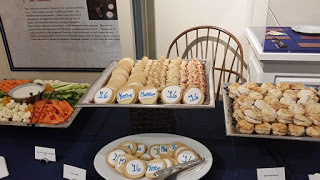 Like all political campaign functions food was provided for the attendees. But instead of the traditional rubber chicken diner, guests munched on delicious " Monroe '16" cookies.
Like all political campaign functions food was provided for the attendees. But instead of the traditional rubber chicken diner, guests munched on delicious " Monroe '16" cookies.
In honor of the upcoming election and the fact that this November celebrates the 200th anniversary of James Monroe's election as the fifth president of the United States, the James Monroe Museum unveiled the new exhibit highlight an eclectic mix of political memorabilia. The items featured in the exhibit range from political cartoons to the wallet of President Warren G. Harding with the president's lucky penny. All of the items came from the personal collection of Laurence Hoes and many of the items have never been displayed before.
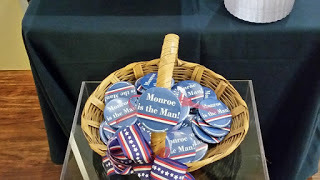 Attendees received a Monroe campaign button. The slogan "Monroe is the Man!" was taken from a lyric from a Monroe campaign song written in 1816.
Attendees received a Monroe campaign button. The slogan "Monroe is the Man!" was taken from a lyric from a Monroe campaign song written in 1816.
Bellow are a few highlights from the exhibit:
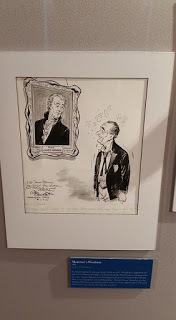
Laurence Hoes was able to acquire numerous original political cartoons from the collection of the Washington Post, including this cartoon from 1965 titled "Monroe's Wisdom," featuring an embattled LBJ seeking advice from the portrait of James Monroe over LBJ's decision to escalate military involvement in Vietnam. LBJ tried to justify his policy in Vietnam by citing the Monroe doctrine. Unfortunately, the American public was not buying it as the caption reads, "They just don't seem to go for the idea like they used to."
 The Tea Pot Dome scandal was the biggest political scandal before Watergate in the 1970's. The scandal. This widow display allowed Americans to express their feelings much in the way Americans use bumper stickers and lawn signs today.
The Tea Pot Dome scandal was the biggest political scandal before Watergate in the 1970's. The scandal. This widow display allowed Americans to express their feelings much in the way Americans use bumper stickers and lawn signs today.

One of the exhibit's more unique items is President Warren G. Harding's wallet complete with lucky penny. Harding carried this 1901 Indian Head penny during the 1920 election. Harding won the election, but died in office in 1923.
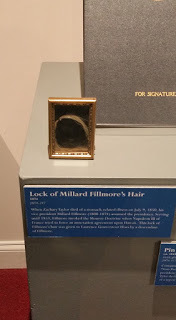 President Millard Fillmore came to office in 1850 after the sudden death of President Zachary Taylor. Laurence Gouverneur Hoes by a descendant of Fillmore.
President Millard Fillmore came to office in 1850 after the sudden death of President Zachary Taylor. Laurence Gouverneur Hoes by a descendant of Fillmore.
 In 1889, President Benjamin Harrison gave the last Peace Medal to Native American chiefs as a token of goodwill and friendship between the US government and Native tribes. The year after this medal was minted the military clashed with the Lakota Sioux in North Dakota culminating with the Wounded Knee massacre where at least 150 Sioux and 25 soldiers were killed.
In 1889, President Benjamin Harrison gave the last Peace Medal to Native American chiefs as a token of goodwill and friendship between the US government and Native tribes. The year after this medal was minted the military clashed with the Lakota Sioux in North Dakota culminating with the Wounded Knee massacre where at least 150 Sioux and 25 soldiers were killed.
 One of my favorite artifacts is this commemorative pitcher made in 1820 and presented to James Monroe. On the front is a poorly executed portrait of James Monroe and on the back is an idealized image of George Washington's tomb. The creamware pitcher was made in England!
One of my favorite artifacts is this commemorative pitcher made in 1820 and presented to James Monroe. On the front is a poorly executed portrait of James Monroe and on the back is an idealized image of George Washington's tomb. The creamware pitcher was made in England!
 This pitcher was made to commemorate President Calvin Coolidge, but there is a major flaw: the Presidential seal was printed upside down! Imported from Liverpool by John H. Roth & Co. it was donated to the James Monroe Museum. "Perhaps, in the many years in the future, the visitors to the James Monroe Memorial Library and Museum [as it was then known] will find the jug both interesting and see that we lived in the late 20th century were as human as mankind has always been," Mr. Roth wrote.
This pitcher was made to commemorate President Calvin Coolidge, but there is a major flaw: the Presidential seal was printed upside down! Imported from Liverpool by John H. Roth & Co. it was donated to the James Monroe Museum. "Perhaps, in the many years in the future, the visitors to the James Monroe Memorial Library and Museum [as it was then known] will find the jug both interesting and see that we lived in the late 20th century were as human as mankind has always been," Mr. Roth wrote.
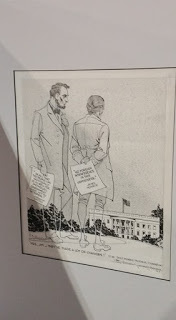
Presidents Abraham Lincoln and James Monroe share the spotlight in the political cartoon from 1963 critical of JFK's handling of communist Cuba. "Yes, Jim...they're made a lot of changes!" the caption declared.
Conduct in the Public Service: Artifacts of Politics and Government from the Collection of the James Monroe Museum is open until March 2017.
To learn more information about the James Monroe Museum please visit: http://jamesmonroemuseum.umw.edu/
 Like all political campaign functions food was provided for the attendees. But instead of the traditional rubber chicken diner, guests munched on delicious " Monroe '16" cookies.
Like all political campaign functions food was provided for the attendees. But instead of the traditional rubber chicken diner, guests munched on delicious " Monroe '16" cookies.In honor of the upcoming election and the fact that this November celebrates the 200th anniversary of James Monroe's election as the fifth president of the United States, the James Monroe Museum unveiled the new exhibit highlight an eclectic mix of political memorabilia. The items featured in the exhibit range from political cartoons to the wallet of President Warren G. Harding with the president's lucky penny. All of the items came from the personal collection of Laurence Hoes and many of the items have never been displayed before.
 Attendees received a Monroe campaign button. The slogan "Monroe is the Man!" was taken from a lyric from a Monroe campaign song written in 1816.
Attendees received a Monroe campaign button. The slogan "Monroe is the Man!" was taken from a lyric from a Monroe campaign song written in 1816.Bellow are a few highlights from the exhibit:

Laurence Hoes was able to acquire numerous original political cartoons from the collection of the Washington Post, including this cartoon from 1965 titled "Monroe's Wisdom," featuring an embattled LBJ seeking advice from the portrait of James Monroe over LBJ's decision to escalate military involvement in Vietnam. LBJ tried to justify his policy in Vietnam by citing the Monroe doctrine. Unfortunately, the American public was not buying it as the caption reads, "They just don't seem to go for the idea like they used to."
 The Tea Pot Dome scandal was the biggest political scandal before Watergate in the 1970's. The scandal. This widow display allowed Americans to express their feelings much in the way Americans use bumper stickers and lawn signs today.
The Tea Pot Dome scandal was the biggest political scandal before Watergate in the 1970's. The scandal. This widow display allowed Americans to express their feelings much in the way Americans use bumper stickers and lawn signs today.
One of the exhibit's more unique items is President Warren G. Harding's wallet complete with lucky penny. Harding carried this 1901 Indian Head penny during the 1920 election. Harding won the election, but died in office in 1923.
 President Millard Fillmore came to office in 1850 after the sudden death of President Zachary Taylor. Laurence Gouverneur Hoes by a descendant of Fillmore.
President Millard Fillmore came to office in 1850 after the sudden death of President Zachary Taylor. Laurence Gouverneur Hoes by a descendant of Fillmore. In 1889, President Benjamin Harrison gave the last Peace Medal to Native American chiefs as a token of goodwill and friendship between the US government and Native tribes. The year after this medal was minted the military clashed with the Lakota Sioux in North Dakota culminating with the Wounded Knee massacre where at least 150 Sioux and 25 soldiers were killed.
In 1889, President Benjamin Harrison gave the last Peace Medal to Native American chiefs as a token of goodwill and friendship between the US government and Native tribes. The year after this medal was minted the military clashed with the Lakota Sioux in North Dakota culminating with the Wounded Knee massacre where at least 150 Sioux and 25 soldiers were killed. One of my favorite artifacts is this commemorative pitcher made in 1820 and presented to James Monroe. On the front is a poorly executed portrait of James Monroe and on the back is an idealized image of George Washington's tomb. The creamware pitcher was made in England!
One of my favorite artifacts is this commemorative pitcher made in 1820 and presented to James Monroe. On the front is a poorly executed portrait of James Monroe and on the back is an idealized image of George Washington's tomb. The creamware pitcher was made in England! This pitcher was made to commemorate President Calvin Coolidge, but there is a major flaw: the Presidential seal was printed upside down! Imported from Liverpool by John H. Roth & Co. it was donated to the James Monroe Museum. "Perhaps, in the many years in the future, the visitors to the James Monroe Memorial Library and Museum [as it was then known] will find the jug both interesting and see that we lived in the late 20th century were as human as mankind has always been," Mr. Roth wrote.
This pitcher was made to commemorate President Calvin Coolidge, but there is a major flaw: the Presidential seal was printed upside down! Imported from Liverpool by John H. Roth & Co. it was donated to the James Monroe Museum. "Perhaps, in the many years in the future, the visitors to the James Monroe Memorial Library and Museum [as it was then known] will find the jug both interesting and see that we lived in the late 20th century were as human as mankind has always been," Mr. Roth wrote.
Presidents Abraham Lincoln and James Monroe share the spotlight in the political cartoon from 1963 critical of JFK's handling of communist Cuba. "Yes, Jim...they're made a lot of changes!" the caption declared.
Conduct in the Public Service: Artifacts of Politics and Government from the Collection of the James Monroe Museum is open until March 2017.
To learn more information about the James Monroe Museum please visit: http://jamesmonroemuseum.umw.edu/
Published on October 01, 2016 10:25
August 15, 2016
Will & Jane at the Folger Shakespeare Library
It sounds like the title of '90s sitcom, but the exhibition Will & Jane: Shakespeare, Austen, and the Cult of Celebrity at the Folger Shakespeare Library charts the many ways the fans of William Shakespeare and Jane Austen have commemorated their favorite authors.

I had the pleasure of visiting the exhibit yesterday at the gorgeous Folger Shakespeare Library in Washington, D.C.
The exhibit charts the many diverse ways the fans of William Shakespeare and Jane Austen have commemorated their love for authors. The exhibition is timed to commemorate the 400th anniversary of the Bards death this year and the upcoming 200th anniversary of Jane's death next year.

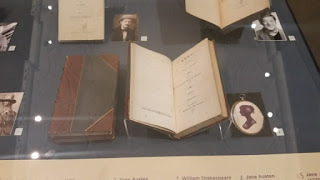
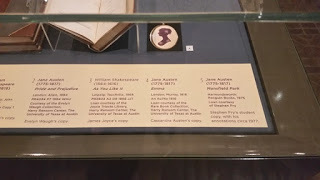
Cassandra Austen's (Jane's sister) first edition copy of Emma from 1816. Cassandra Austen was very proud of her sister's achievements and just the thought that both Jane Austen and Cassandra Austen handled that book gave me chills.
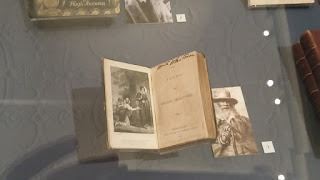
Walt Whitman's copy of Shakespeare's Sonnets that the poet carried in his pocket. Dating from the Civil War era, I had to wonder if Whitman brought this book with him when he came to Fredericksburg to nurse Union soldiers.
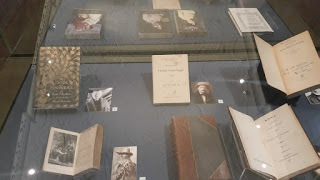
Evelyn Waugh's gilded copy of Jane Austen's Pride and Prejudice, James Joyce's coffee stained copy of William Shakespeare's comedy As You Like It, and Stephen Fry's battered paperback copy of Jane Austen's Mansfield Park.
Some author's have attempted to cash in on the mania for works connected with William Shakespeare and Jane Austen by producing parodies of the authors famous works.
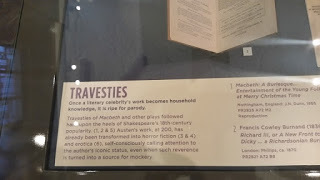
I agree with this title.

The most popular travesty of all is Seth Grahame-Smith's Pride and Prejudice and Zombies which combined the love for Jane Austen's popular novel with popular culture's fascination with zombies. Hailed as a comic masterpiece by some critics, the funniest lines in the novel come not from the hands of Grahame-Smith, but from Austen.
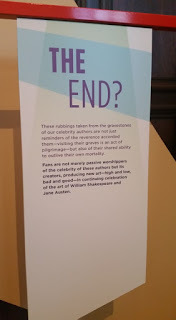


Not content to simple visit the grave of William Shakespeare at grave at the Church of the Holy Trinity at Stratford-upon-Avon and the grave of Jane Austen at Winchester Cathedral, some fans have taken grave rubbings to bring home with them.

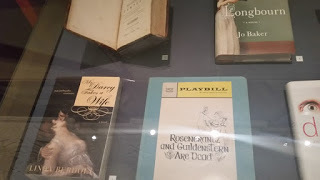
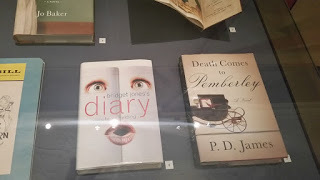
Examples of fan fiction of various quality.
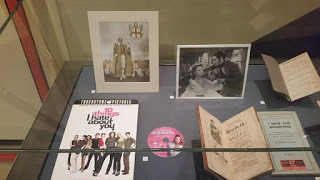
The works of William Shakespeare and Jane Austen has inspired countless movie adaptions. Some adaptions featured the some actors in different roles as seen here in promotional material for the films Hamlet (1948) and Pride and Prejudice (1940) which both starred Sir Laurence Olivier in the staring roles.
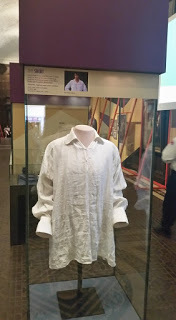
No adaption of Jane Austen's work has inspired as much love and adoration from fans than the 1995 BBC mini-series Pride and Prejudice staring Colin Firth as Mr. Darcy and Jennifer Elhe as Elizabeth Bennet. Countless female fans swooned over the scene of Mr. Darcy emerging from the pond at Pemberley in a wet shirt. Ironically, this scene which became the most memorable and iconic moment of the series was not in the original novel.

Of course, I had to have my picture taken next to it.
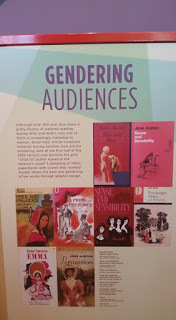
A selection of covers for the novels of Jane Austen from the 1960's. While the covers of William Shakespeare's plays and poems are serious and scholarly, the works of Jane Austen have been regulated to the status of "chick lit" with frothy covers of women in bonnets and lots of pink.

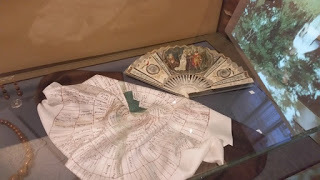
Not content with just reading the works of William Shakespeare and Jane Austen, fans have crafted items with the authors and their characters on clothing, jewelry, and accessories. This case featured a wooden jewelry set carved from a tree mentioned in The Merry Wives of Windsor from the 19th-century, a silk scarf with Jane Austen's family tree, and an 18th-century silk fan depicting the wedding scene from Henry V.
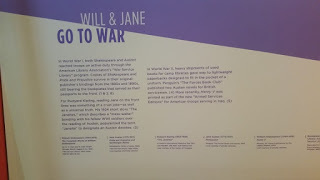
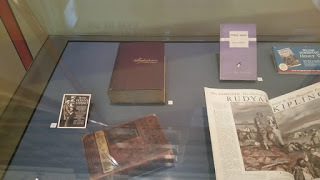
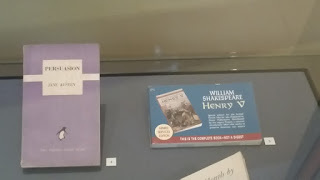
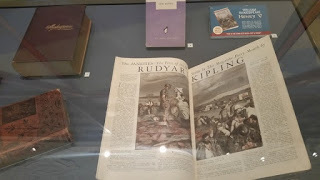
During World War I and II, the works of William Shakespeare where sent to the front to entertain the soldiers. Author Rudyard Kipling popularized the term "Janeites" to describe the fans of Jane Austen in story published about a group of English soldiers who read Austen in the trenches of World War I.
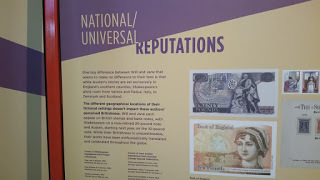

The image of William Shakespeare and Jane Austen has appeared on English stamps and pound notes. Jane Austen will make her debut on the British 10 pound note next year.
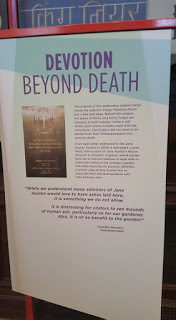
Some fans have been so dedicated to their literary hero that they decided to spend all eternity with them. The Folger Shakespeare Library was created by Henry and Emily Folger who spent their lives and fortune to purchase rare items connected to William Shakespeare resulting in the Library. The Folgers who were childless, are interned in the reading room at the Library. The Jane Austen House Museum at Chawton had had a similar problem with devoted fans requesting that their ashes be scattered in the garden--much to the dismay of the gardener.
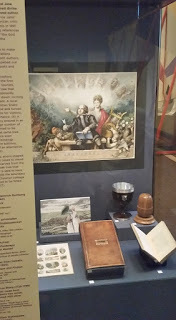 The cults of William Shakespeare and Jane Austen has reached near religious worship. Pilgrims can tour sites connected to the authors. On display is a chalice carved from a piece of wood from a tree said to have been planted by William Shakespeare alongside it is a darning egg carved from a piece a wood from a tree that Jane Austen planted in Chawton.
The cults of William Shakespeare and Jane Austen has reached near religious worship. Pilgrims can tour sites connected to the authors. On display is a chalice carved from a piece of wood from a tree said to have been planted by William Shakespeare alongside it is a darning egg carved from a piece a wood from a tree that Jane Austen planted in Chawton.
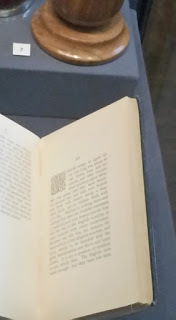
From William Dean Howell's Criticism and Fiction, where he coined the term "the divine Jane." A term still in use today within Jane Austen fan culture.
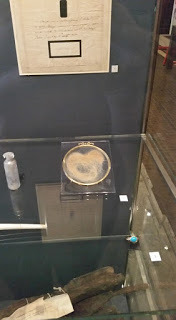
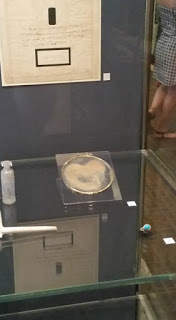
A lock of Jane Austen's hair.

A purported strand of William Shakespeare's hair.
 Simple household items found under the floorboards at Jane Austen's home in Chawton testify to the fact that even the humblest items can become relics simple because they were from the house Jane Austen lived in.
Simple household items found under the floorboards at Jane Austen's home in Chawton testify to the fact that even the humblest items can become relics simple because they were from the house Jane Austen lived in.
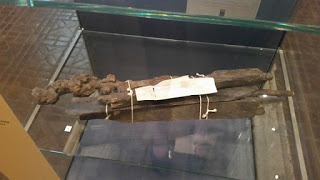
All that remain's from a chair from William Shakespeare's birthplace.


The popularity of the works of William Shakespeare and Jane Austen depend on creating new fans every generation. To fill that void, manufactures have produced child friendly adaptions and toys.

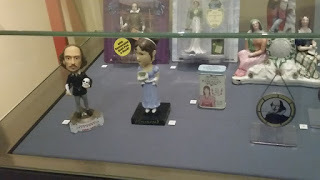

Manufactures have also seen that adults are just as eager to purchase objects featuring the image of William Shakespeare and Jane Austen from ceramic figurines, action figures, bobble head doll, sun catchers, and band aids.
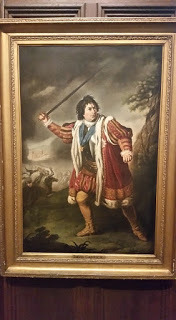
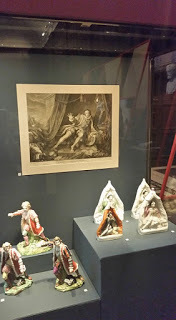
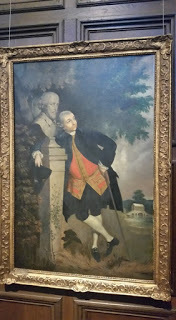
Actors have become as equally famous as the author in the public imagination for playing one of William Shakespeare's or Jane Austen's characters. One of the first actors to reach this level of celebrity was the famed 18th-century actor David Garrick's whose image was reproduced in prints and ceramic figurines in the guise of Richard III. Garrick paid homage to William Shakespeare by posing with a bust of Shakespeare in the 1769 painting shown above.

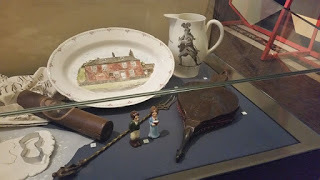
An example of the products produced with the likeness of William Shakespeare, Jane Austen, and their characters that fans can purchase.

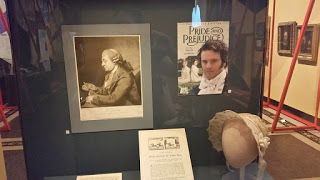
The bonnet worn by actress Susannah Harker (Jane Bennet) in the 1995 BBC mini-series Pride and Prejudice.

William Shakespeare and Jane Austen have been used to advertise a variety of products.
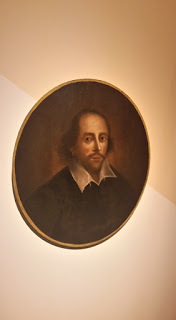
A rare 17th/18th-century English pub sign depicting William Shakespeare. I wonder how many of the pubs patrons where inspired to write awful poems while sipping a pint?
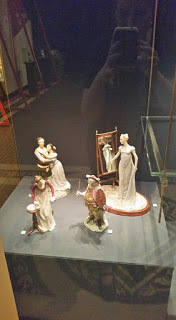
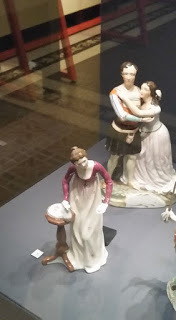
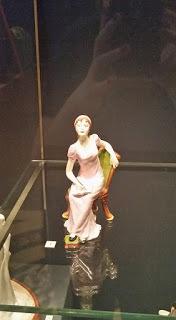
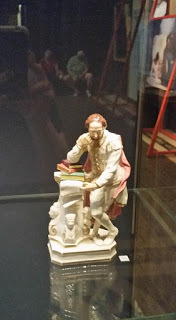

In the 19th-century Victorians collected porclein figurines of William Shakespeare and his characters to adorn their parlors. Today, Jane Austen has replaced the Bard with companies such as the Franklin Mint producing pricey limited editions. Like the figurines of David Garrick as Richard III, modern manufactures have copied the likeness of actress Gwyneth Paltrow as Emma Woodhouse and Jennifer Ehle and Elizabeth Bennet. Though the Elizabeth Bennet figurine looks like she is ready to through the tea cup and saucer across the parlor like a Frisbee; perhaps at Lady Catherine de Bough?

Both William Shakespeare and Jane Austen have missing chapters in their personal lives. These gaps have frustrated fans and scholars alike. To fill these missing areas, fans have created myths and legends surrounding William Shakespeare's and Jane Austen's love lives. Disturbed that there was no evidence to suggest love between William Shakespeare and his wife Anne Hathaway, a love letter was forged in the 1790s to give the great romance writer passion in his private life. Jane Austen's fans have also struggled with Jane Austen's spinsterhood and the 2007 film Becoming Jane staring actress Anne Hathaway as Jane Austen presented the fictionalized interpretation of the authors real life relationship with Tom Lefroy.
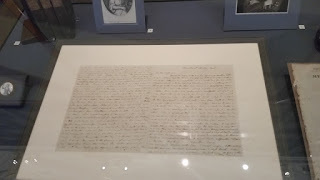
Jane Austen was also a fan of William Shakespeare, growing up in the years following the mania surrounding the 200th anniversary of Shakespeare's birth in 1769. In the original letter above, Jane Austen wrote to her sister Cassandra Austen describing her attendance of a performance of The Merchant of Venice on 5 March 1814 in London. Ironically, she is staying on Hamilton Street.
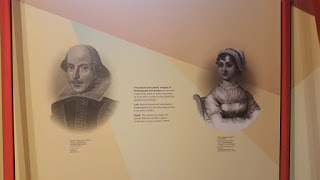

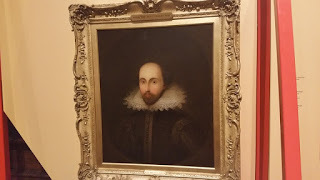
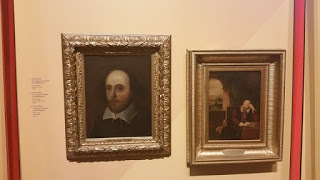
William Shakespeare and Jane Austen share many similarities, including the fact that we are not 100 percent sure what they actually looked like. No image of William Shakespeare painted during his lifetime is known to exist. The first recorded image was produced in 1623 on the title page of the First Folio, the first printed collection of Shakespeare's plays. Jane Austen suffered from a similar problem. Only one image of Jane Austen taken in life is known to exist. A rather unflattering pen and ink drawing done by Cassandra Austen. The image was dolled up in the 1870's when Jane Austen's nephew published his memoir of his famous aunt. Since then artist have been inspired to produce their own images of the authors.


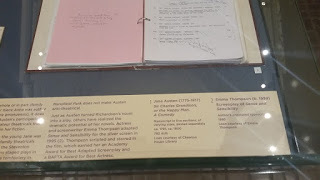

The exhibit colludes with an examination of Jane Austen's love of the theater, Handwritten script of Sir Charles Grandison testified to the Austen's family love of amateur theatricals. Jane Austen's script is displayed next to actress Emma Thompson's script from the 1995 movie Sense and Sensibility.
Will & Jane: Shakespeare, Austen, and the Cult of Celebrity is a delightful exhibit full of surprises. With 2017 marking the 200th anniversary of Jane Austen's death, her cult of celebrity is gearing up for even more movies, books, and products devoted to the author that many call Jane.
Will & Jane: Shakespeare, Austen, and the Cult of Celebrity is on display from August 6, 2016-November 6, 2016.
http://www.folger.edu/

I had the pleasure of visiting the exhibit yesterday at the gorgeous Folger Shakespeare Library in Washington, D.C.
The exhibit charts the many diverse ways the fans of William Shakespeare and Jane Austen have commemorated their love for authors. The exhibition is timed to commemorate the 400th anniversary of the Bards death this year and the upcoming 200th anniversary of Jane's death next year.



Cassandra Austen's (Jane's sister) first edition copy of Emma from 1816. Cassandra Austen was very proud of her sister's achievements and just the thought that both Jane Austen and Cassandra Austen handled that book gave me chills.

Walt Whitman's copy of Shakespeare's Sonnets that the poet carried in his pocket. Dating from the Civil War era, I had to wonder if Whitman brought this book with him when he came to Fredericksburg to nurse Union soldiers.

Evelyn Waugh's gilded copy of Jane Austen's Pride and Prejudice, James Joyce's coffee stained copy of William Shakespeare's comedy As You Like It, and Stephen Fry's battered paperback copy of Jane Austen's Mansfield Park.
Some author's have attempted to cash in on the mania for works connected with William Shakespeare and Jane Austen by producing parodies of the authors famous works.

I agree with this title.

The most popular travesty of all is Seth Grahame-Smith's Pride and Prejudice and Zombies which combined the love for Jane Austen's popular novel with popular culture's fascination with zombies. Hailed as a comic masterpiece by some critics, the funniest lines in the novel come not from the hands of Grahame-Smith, but from Austen.



Not content to simple visit the grave of William Shakespeare at grave at the Church of the Holy Trinity at Stratford-upon-Avon and the grave of Jane Austen at Winchester Cathedral, some fans have taken grave rubbings to bring home with them.



Examples of fan fiction of various quality.

The works of William Shakespeare and Jane Austen has inspired countless movie adaptions. Some adaptions featured the some actors in different roles as seen here in promotional material for the films Hamlet (1948) and Pride and Prejudice (1940) which both starred Sir Laurence Olivier in the staring roles.

No adaption of Jane Austen's work has inspired as much love and adoration from fans than the 1995 BBC mini-series Pride and Prejudice staring Colin Firth as Mr. Darcy and Jennifer Elhe as Elizabeth Bennet. Countless female fans swooned over the scene of Mr. Darcy emerging from the pond at Pemberley in a wet shirt. Ironically, this scene which became the most memorable and iconic moment of the series was not in the original novel.

Of course, I had to have my picture taken next to it.

A selection of covers for the novels of Jane Austen from the 1960's. While the covers of William Shakespeare's plays and poems are serious and scholarly, the works of Jane Austen have been regulated to the status of "chick lit" with frothy covers of women in bonnets and lots of pink.


Not content with just reading the works of William Shakespeare and Jane Austen, fans have crafted items with the authors and their characters on clothing, jewelry, and accessories. This case featured a wooden jewelry set carved from a tree mentioned in The Merry Wives of Windsor from the 19th-century, a silk scarf with Jane Austen's family tree, and an 18th-century silk fan depicting the wedding scene from Henry V.




During World War I and II, the works of William Shakespeare where sent to the front to entertain the soldiers. Author Rudyard Kipling popularized the term "Janeites" to describe the fans of Jane Austen in story published about a group of English soldiers who read Austen in the trenches of World War I.


The image of William Shakespeare and Jane Austen has appeared on English stamps and pound notes. Jane Austen will make her debut on the British 10 pound note next year.

Some fans have been so dedicated to their literary hero that they decided to spend all eternity with them. The Folger Shakespeare Library was created by Henry and Emily Folger who spent their lives and fortune to purchase rare items connected to William Shakespeare resulting in the Library. The Folgers who were childless, are interned in the reading room at the Library. The Jane Austen House Museum at Chawton had had a similar problem with devoted fans requesting that their ashes be scattered in the garden--much to the dismay of the gardener.
 The cults of William Shakespeare and Jane Austen has reached near religious worship. Pilgrims can tour sites connected to the authors. On display is a chalice carved from a piece of wood from a tree said to have been planted by William Shakespeare alongside it is a darning egg carved from a piece a wood from a tree that Jane Austen planted in Chawton.
The cults of William Shakespeare and Jane Austen has reached near religious worship. Pilgrims can tour sites connected to the authors. On display is a chalice carved from a piece of wood from a tree said to have been planted by William Shakespeare alongside it is a darning egg carved from a piece a wood from a tree that Jane Austen planted in Chawton. 
From William Dean Howell's Criticism and Fiction, where he coined the term "the divine Jane." A term still in use today within Jane Austen fan culture.


A lock of Jane Austen's hair.

A purported strand of William Shakespeare's hair.
 Simple household items found under the floorboards at Jane Austen's home in Chawton testify to the fact that even the humblest items can become relics simple because they were from the house Jane Austen lived in.
Simple household items found under the floorboards at Jane Austen's home in Chawton testify to the fact that even the humblest items can become relics simple because they were from the house Jane Austen lived in.
All that remain's from a chair from William Shakespeare's birthplace.


The popularity of the works of William Shakespeare and Jane Austen depend on creating new fans every generation. To fill that void, manufactures have produced child friendly adaptions and toys.



Manufactures have also seen that adults are just as eager to purchase objects featuring the image of William Shakespeare and Jane Austen from ceramic figurines, action figures, bobble head doll, sun catchers, and band aids.



Actors have become as equally famous as the author in the public imagination for playing one of William Shakespeare's or Jane Austen's characters. One of the first actors to reach this level of celebrity was the famed 18th-century actor David Garrick's whose image was reproduced in prints and ceramic figurines in the guise of Richard III. Garrick paid homage to William Shakespeare by posing with a bust of Shakespeare in the 1769 painting shown above.


An example of the products produced with the likeness of William Shakespeare, Jane Austen, and their characters that fans can purchase.


The bonnet worn by actress Susannah Harker (Jane Bennet) in the 1995 BBC mini-series Pride and Prejudice.

William Shakespeare and Jane Austen have been used to advertise a variety of products.

A rare 17th/18th-century English pub sign depicting William Shakespeare. I wonder how many of the pubs patrons where inspired to write awful poems while sipping a pint?





In the 19th-century Victorians collected porclein figurines of William Shakespeare and his characters to adorn their parlors. Today, Jane Austen has replaced the Bard with companies such as the Franklin Mint producing pricey limited editions. Like the figurines of David Garrick as Richard III, modern manufactures have copied the likeness of actress Gwyneth Paltrow as Emma Woodhouse and Jennifer Ehle and Elizabeth Bennet. Though the Elizabeth Bennet figurine looks like she is ready to through the tea cup and saucer across the parlor like a Frisbee; perhaps at Lady Catherine de Bough?

Both William Shakespeare and Jane Austen have missing chapters in their personal lives. These gaps have frustrated fans and scholars alike. To fill these missing areas, fans have created myths and legends surrounding William Shakespeare's and Jane Austen's love lives. Disturbed that there was no evidence to suggest love between William Shakespeare and his wife Anne Hathaway, a love letter was forged in the 1790s to give the great romance writer passion in his private life. Jane Austen's fans have also struggled with Jane Austen's spinsterhood and the 2007 film Becoming Jane staring actress Anne Hathaway as Jane Austen presented the fictionalized interpretation of the authors real life relationship with Tom Lefroy.

Jane Austen was also a fan of William Shakespeare, growing up in the years following the mania surrounding the 200th anniversary of Shakespeare's birth in 1769. In the original letter above, Jane Austen wrote to her sister Cassandra Austen describing her attendance of a performance of The Merchant of Venice on 5 March 1814 in London. Ironically, she is staying on Hamilton Street.




William Shakespeare and Jane Austen share many similarities, including the fact that we are not 100 percent sure what they actually looked like. No image of William Shakespeare painted during his lifetime is known to exist. The first recorded image was produced in 1623 on the title page of the First Folio, the first printed collection of Shakespeare's plays. Jane Austen suffered from a similar problem. Only one image of Jane Austen taken in life is known to exist. A rather unflattering pen and ink drawing done by Cassandra Austen. The image was dolled up in the 1870's when Jane Austen's nephew published his memoir of his famous aunt. Since then artist have been inspired to produce their own images of the authors.




The exhibit colludes with an examination of Jane Austen's love of the theater, Handwritten script of Sir Charles Grandison testified to the Austen's family love of amateur theatricals. Jane Austen's script is displayed next to actress Emma Thompson's script from the 1995 movie Sense and Sensibility.
Will & Jane: Shakespeare, Austen, and the Cult of Celebrity is a delightful exhibit full of surprises. With 2017 marking the 200th anniversary of Jane Austen's death, her cult of celebrity is gearing up for even more movies, books, and products devoted to the author that many call Jane.
Will & Jane: Shakespeare, Austen, and the Cult of Celebrity is on display from August 6, 2016-November 6, 2016.
http://www.folger.edu/
Published on August 15, 2016 13:03
March 15, 2016
Book Review: Hanging Mary
I have been waiting, and waiting for Susan Higginbotham's novel Hanging Mary to be released since I first heard about it last year. So imagine my complete joy when I found an early copy of Hanging Mary last week at my local Books a Million five days before the scheduled release. My eager anticipation for the novel was worth it. Hanging Mary is one of the best novels about the Civil War that I have read in years.
Hanging Mary tells the story of Mary Surratt and her involvement in John Wilkes Booth's conspiracy to assassinate President Abraham Lincoln. For those who are unfamiliar with the Lincoln conspiracy, Mary Surratt operated a boardinghouse in Washington, D.C. that was frequented by John Wilkes Booth during the winter of 1864-1865. Mary's son, John Surratt, served as a courier for the Confederacy and was introduced to Booth. John Surratt became a valued member of the plot to kidnap President Lincoln. Booth hoped that by kidnapping the president, he could force the North to the bargaining table and win independence for the beleaguered Confederacy. Sometime after the fall of Richmond in April 1865, Booth abandoned scheme to kidnap Lincoln to assassinating the president and decapitating the government. John Surratt's involvement in the assassination has been open for debate for over a 150 years. Equally controversial has been Mary Surratt's place in the conspiracy. Arrested following the assassination and put on trail under a military tribunal. Mary Surratt was convicted as an accessory she became the first woman sentenced to death by the United States government and hung on July 7, 1865 along with George Atzerodt, David Herold, and Lewis Powell (Paine/Payne).
Hanging Mary is narrated by Mary Surratt and Nora Fitzpatrick who boarded at Mary Surratt's boardinghouse. Starting in the fall of 1864, when Mary moved to Washington to operate a boardinghouse to July 7, 1865 the novel follows the events in alternating chapters between Mary and Nora's viewpoints. I have never had much pity for what happened to Mary Surratt, Hanging Mary has succeeded in making Mary a deeply flawed, yet sympathetic character. While guilty of involvement in the plan to kidnap President Lincoln, the novel questions Mary Surratt's involvement in the assassination. Higginbotham also succeeded in making Nora Fitzpatrick, who is usually treated as a minor figure in the historical accounts of the Lincoln assassination, into a fully fleshed out character.
A compelling and well written historical novel, Higginbotham accurately portrays the morals and customs of Civil War era America. Though I already knew how the novel was going to end, I found the deception of the events surrounding the execution heartrending. Hanging Mary is historical fiction at its best.
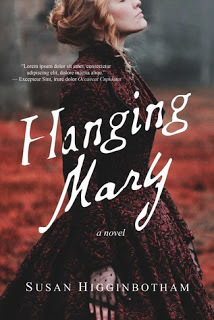 Hanging Mary by Susan Higginbotham published by Sourcebooks Landmark is available today on Amazon
Hanging Mary by Susan Higginbotham published by Sourcebooks Landmark is available today on Amazon
Hanging Mary tells the story of Mary Surratt and her involvement in John Wilkes Booth's conspiracy to assassinate President Abraham Lincoln. For those who are unfamiliar with the Lincoln conspiracy, Mary Surratt operated a boardinghouse in Washington, D.C. that was frequented by John Wilkes Booth during the winter of 1864-1865. Mary's son, John Surratt, served as a courier for the Confederacy and was introduced to Booth. John Surratt became a valued member of the plot to kidnap President Lincoln. Booth hoped that by kidnapping the president, he could force the North to the bargaining table and win independence for the beleaguered Confederacy. Sometime after the fall of Richmond in April 1865, Booth abandoned scheme to kidnap Lincoln to assassinating the president and decapitating the government. John Surratt's involvement in the assassination has been open for debate for over a 150 years. Equally controversial has been Mary Surratt's place in the conspiracy. Arrested following the assassination and put on trail under a military tribunal. Mary Surratt was convicted as an accessory she became the first woman sentenced to death by the United States government and hung on July 7, 1865 along with George Atzerodt, David Herold, and Lewis Powell (Paine/Payne).
Hanging Mary is narrated by Mary Surratt and Nora Fitzpatrick who boarded at Mary Surratt's boardinghouse. Starting in the fall of 1864, when Mary moved to Washington to operate a boardinghouse to July 7, 1865 the novel follows the events in alternating chapters between Mary and Nora's viewpoints. I have never had much pity for what happened to Mary Surratt, Hanging Mary has succeeded in making Mary a deeply flawed, yet sympathetic character. While guilty of involvement in the plan to kidnap President Lincoln, the novel questions Mary Surratt's involvement in the assassination. Higginbotham also succeeded in making Nora Fitzpatrick, who is usually treated as a minor figure in the historical accounts of the Lincoln assassination, into a fully fleshed out character.
A compelling and well written historical novel, Higginbotham accurately portrays the morals and customs of Civil War era America. Though I already knew how the novel was going to end, I found the deception of the events surrounding the execution heartrending. Hanging Mary is historical fiction at its best.
 Hanging Mary by Susan Higginbotham published by Sourcebooks Landmark is available today on Amazon
Hanging Mary by Susan Higginbotham published by Sourcebooks Landmark is available today on Amazon
Published on March 15, 2016 11:44
February 16, 2016
Lincoln's Birthday in Springfield
Last week, I had the pleasure of having a book signing at the Lincoln Home National Historic Site as part of Abraham Lincoln's birthday celebration. It was a thrill to be invited back to the Lincoln Home. As part of the birthday festivities the NPS held a lecture series followed by the book signing. It was a lovely event, though a little chill. Over night Springfield had been hit by an unexpected snow shower. The chilly weather did not deter the public and I loved meeting and talking with fellow Lincoln buffs.
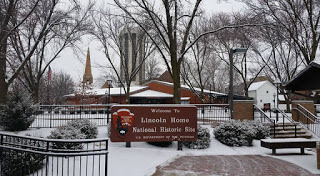 The city was coated in a fresh coating of snow after an unexpected snow shower.
The city was coated in a fresh coating of snow after an unexpected snow shower.
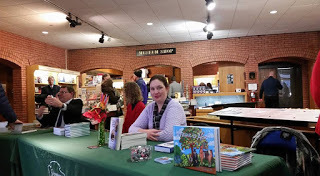
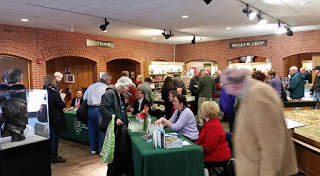 The Visitor Center was filled following the lecture. The chilly weather did not keep visitors away.
The Visitor Center was filled following the lecture. The chilly weather did not keep visitors away.
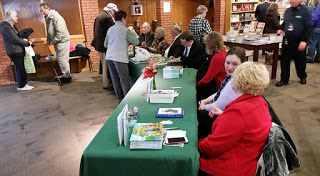 Talking to Carla Mayernick, author of Where is Abe? a children's book that she wrote to introduce her grandchild to Abraham Lincoln after discovering that there was not a book for three-year-old's about Lincoln. To learn more about this charming book visit Where is Abe?
Talking to Carla Mayernick, author of Where is Abe? a children's book that she wrote to introduce her grandchild to Abraham Lincoln after discovering that there was not a book for three-year-old's about Lincoln. To learn more about this charming book visit Where is Abe?
Also at the book signing where historian Bryon C. Andreasen who spearheaded the Looking for Lincoln project of informative displays throughout the city and state about sites and topics connected to Abraham Lincoln. His two books Looking for Lincoln In Illinois: Lincoln's Springfield and Looking for Lincoln In Illinois: Lincoln and Mormon Country are a wealth of information and highly recommended as a tour book for the tourist or the armchair travel. To learn more about the project visit Looking for Lincoln
Bonnie Paull and Richard E. Hart where on hand to sign copies of their fantastic book Lincoln's Springfield Neighborhood. Available on Amazon--a must read for those interested in the personal life of Abraham Lincoln before the Civil War. Paull and Hart researched reveals that the Lincolns where generally loved by their neighbors and the family was known for their charity and entertainments.
Glenna R. Schroeder-Lein signed copies of her book Lincoln and Medicine (available on Amazon)
It was a pleasure to meet the renowned Lincoln scholar, Wayne C. Temple who signed my copy of Lincoln's Surgeons at His Assassination which can also be purchased on Amazon.
After the book signing I went over to the Abraham Lincoln Presidential Library and Museum to see my friend Pam Brown who brings Mary Lincoln to life. Along with visiting with Pam, I visited the Taper Gallery at the Museum featuring the gems of the institutions collection. On display, where Mary Lincoln's personal family china that she ordered after the 1864 election for the second term. It was very understated compared to the china ordered for the first term. The buff coloring appears peach under certain light unlike the bold solferino that Mary Lincoln picked for the first term. Also on display was Mary Lincoln's music box that she purchased after her husband's death. Following Abraham Lincoln's assassination, Mary never entered a theater again.
Sadly, my trip to Springfield was brief, but I enjoyed celebrating Abraham Lincoln's 207th birthday in the city that he loved.
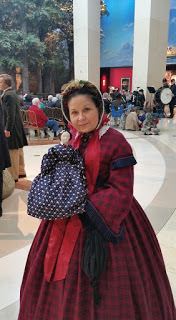 Mary Lincoln (Pam Brown) posing with my doll Mary Virginia.
Mary Lincoln (Pam Brown) posing with my doll Mary Virginia.
 The city was coated in a fresh coating of snow after an unexpected snow shower.
The city was coated in a fresh coating of snow after an unexpected snow shower.
 The Visitor Center was filled following the lecture. The chilly weather did not keep visitors away.
The Visitor Center was filled following the lecture. The chilly weather did not keep visitors away. Talking to Carla Mayernick, author of Where is Abe? a children's book that she wrote to introduce her grandchild to Abraham Lincoln after discovering that there was not a book for three-year-old's about Lincoln. To learn more about this charming book visit Where is Abe?
Talking to Carla Mayernick, author of Where is Abe? a children's book that she wrote to introduce her grandchild to Abraham Lincoln after discovering that there was not a book for three-year-old's about Lincoln. To learn more about this charming book visit Where is Abe?Also at the book signing where historian Bryon C. Andreasen who spearheaded the Looking for Lincoln project of informative displays throughout the city and state about sites and topics connected to Abraham Lincoln. His two books Looking for Lincoln In Illinois: Lincoln's Springfield and Looking for Lincoln In Illinois: Lincoln and Mormon Country are a wealth of information and highly recommended as a tour book for the tourist or the armchair travel. To learn more about the project visit Looking for Lincoln
Bonnie Paull and Richard E. Hart where on hand to sign copies of their fantastic book Lincoln's Springfield Neighborhood. Available on Amazon--a must read for those interested in the personal life of Abraham Lincoln before the Civil War. Paull and Hart researched reveals that the Lincolns where generally loved by their neighbors and the family was known for their charity and entertainments.
Glenna R. Schroeder-Lein signed copies of her book Lincoln and Medicine (available on Amazon)
It was a pleasure to meet the renowned Lincoln scholar, Wayne C. Temple who signed my copy of Lincoln's Surgeons at His Assassination which can also be purchased on Amazon.
After the book signing I went over to the Abraham Lincoln Presidential Library and Museum to see my friend Pam Brown who brings Mary Lincoln to life. Along with visiting with Pam, I visited the Taper Gallery at the Museum featuring the gems of the institutions collection. On display, where Mary Lincoln's personal family china that she ordered after the 1864 election for the second term. It was very understated compared to the china ordered for the first term. The buff coloring appears peach under certain light unlike the bold solferino that Mary Lincoln picked for the first term. Also on display was Mary Lincoln's music box that she purchased after her husband's death. Following Abraham Lincoln's assassination, Mary never entered a theater again.
Sadly, my trip to Springfield was brief, but I enjoyed celebrating Abraham Lincoln's 207th birthday in the city that he loved.
 Mary Lincoln (Pam Brown) posing with my doll Mary Virginia.
Mary Lincoln (Pam Brown) posing with my doll Mary Virginia.
Published on February 16, 2016 18:21
January 26, 2016
I Met a Ghost at Gettysburg
In the spring of 2015, journalist Don Allison and his grandson went to Gettysburg to explore the areas Civil War history. As part of their vacation, Allison went on a private ghost tour of Sachs Bridge. Near the end of the investigation, Allison had an experience that confirmed for him that ghosts are a reality. Don Allison's ghost adventures are charted in his memoir I Met a Ghost at Gettysburg: A Journey Into the Paranormal. Allison is a respected journalist who has received numerous awards for his reporting for The Bryan Times in Bryan, Ohio. A self-proclaimed skeptic, Allison never believed in the paranormal. That all began to change after Allison and his wife, Diane, purchased an historic house in on Highway 127 in Bryan, Ohio. The house dated to 1835 and had been allowed to deteriorate. Allison and Diane brought the house back to its former glory. But during the restoration process, it quickly became apparent that they were not the only resident in the house. Allison became aware of the history's haunted reputation when a former tenant stopped by and told them of his experiences from ghostly footsteps to the sighting of alien beings. Naturally, Allison scoffed at the reports, joking with his wife that the stories explained why there were so many empty beer bottles found on the property. But soon Allison began to experience things that he could not explain.
Convinced that the house was haunted, Allison gradual came to terms with his houses non-paying tenants. Seeking clarity into the paranormal, Allison contacted famed Gettysburg ghost research Mark Nesbitt. The information that Nesbitt provided gave Allison peace of mind that he was not alone or going crazy. While in Gettysburg in a trip in 2009, Allison began experiencing paranormal activity. Fascinated with the Civil War, Allison decided to take his grandson, Connor, on a Gettysburg vacation in March 2015. The intention of the trip was to explore the Civil War history of Gettysburg, but in the process they got more than they expected. From ghostly footsteps in the hotel room to the sounds of a Civil War era cannon blast, Allison realized that this was going to be a memorable vacation. The paranormal investigation on Sachs Bridge connected Allison to the paranormal in unimaginable ways for Allison. Speaking through a spirit box, Allison became convinced that he was speaking with the spirit of an Ohioan captain that died at Gettysburg. The events at Gettysburg convinced Allison that he needed to share his paranormal journey with the public, the result is this book.
An entertaining memoir of one man's paranormal adventures. Allison writes as the average man, someone who never actively pursued the paranormal until he unexpectedly encountered it. A refreshing paranormal memoir, as the haunting that Allison experienced was benign and friendly in nature. A recommended read for those fascinated by the paranormal and the ghosts of Gettysburg.
 Available on Amazon
Available on Amazon
Visit Don Allison at Faded Banner Publications
Convinced that the house was haunted, Allison gradual came to terms with his houses non-paying tenants. Seeking clarity into the paranormal, Allison contacted famed Gettysburg ghost research Mark Nesbitt. The information that Nesbitt provided gave Allison peace of mind that he was not alone or going crazy. While in Gettysburg in a trip in 2009, Allison began experiencing paranormal activity. Fascinated with the Civil War, Allison decided to take his grandson, Connor, on a Gettysburg vacation in March 2015. The intention of the trip was to explore the Civil War history of Gettysburg, but in the process they got more than they expected. From ghostly footsteps in the hotel room to the sounds of a Civil War era cannon blast, Allison realized that this was going to be a memorable vacation. The paranormal investigation on Sachs Bridge connected Allison to the paranormal in unimaginable ways for Allison. Speaking through a spirit box, Allison became convinced that he was speaking with the spirit of an Ohioan captain that died at Gettysburg. The events at Gettysburg convinced Allison that he needed to share his paranormal journey with the public, the result is this book.
An entertaining memoir of one man's paranormal adventures. Allison writes as the average man, someone who never actively pursued the paranormal until he unexpectedly encountered it. A refreshing paranormal memoir, as the haunting that Allison experienced was benign and friendly in nature. A recommended read for those fascinated by the paranormal and the ghosts of Gettysburg.
 Available on Amazon
Available on AmazonVisit Don Allison at Faded Banner Publications
Published on January 26, 2016 08:12
January 23, 2016
Amanda's Secret
On Thursday, I had the pleasure of reading Jami Borek's charming Amanda's Secret: A Colonel Girl's Story. The story follows the adventures of twelve-year-old Amanda Lambertson who lives with her parents on a plantation outside of Williamsburg, Virginia in the early 1770s. Amanda is excited that she is attending her first ball, as she rarely gets a chance to socialize outside of her close-knit plantation. But her excitement is dampened by the odd remarks of her new servant Jane who starts to hint that Amanda is not a "lady" after all. These remarks sets off a series of events that causes Amanda to learn the truth about her past and her family.
A delightful story for the young and the young at heart. Amanda is a winning heroine and Jami Borek should be applauded for creating a hiss worthy villain in the character of Jane. Jami Borek tale is illustrated with charming photographs textured to look like illustrations in a vain similar to the classic American Girl books. I was pleased that the clothing of the characters was authentic. I was enchanted by the story.
Verdict: 4.5 out of 5
 Amanda's Secret is available on Amazon
Amanda's Secret is available on Amazon
Visit Jami Borek at Shrewsbury Press
A delightful story for the young and the young at heart. Amanda is a winning heroine and Jami Borek should be applauded for creating a hiss worthy villain in the character of Jane. Jami Borek tale is illustrated with charming photographs textured to look like illustrations in a vain similar to the classic American Girl books. I was pleased that the clothing of the characters was authentic. I was enchanted by the story.
Verdict: 4.5 out of 5
 Amanda's Secret is available on Amazon
Amanda's Secret is available on AmazonVisit Jami Borek at Shrewsbury Press
Published on January 23, 2016 10:11



